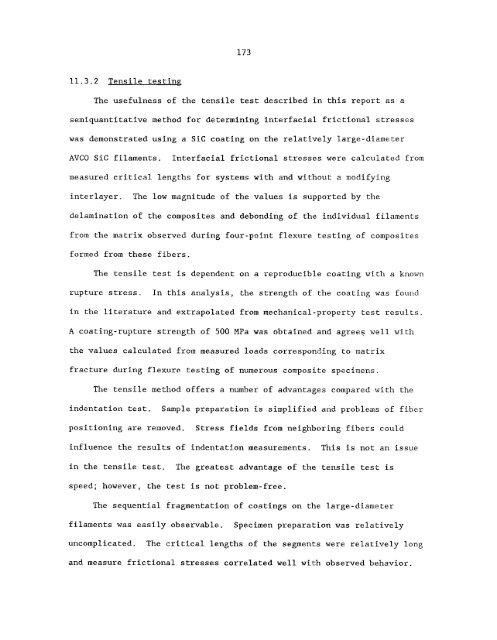Characterization and control of the fiber-matrix interface in ceramic ...
Characterization and control of the fiber-matrix interface in ceramic ...
Characterization and control of the fiber-matrix interface in ceramic ...
You also want an ePaper? Increase the reach of your titles
YUMPU automatically turns print PDFs into web optimized ePapers that Google loves.
173<br />
11.3.2 Tensile test<strong>in</strong>p,<br />
The usefulness <strong>of</strong> <strong>the</strong> tensile test described <strong>in</strong> this report as a<br />
semiquantitative method for determ<strong>in</strong><strong>in</strong>g <strong>in</strong>terfacial frictional stresses<br />
was demonstrated us<strong>in</strong>g a Sic coat<strong>in</strong>g on <strong>the</strong> relatively large-diameter<br />
AVCO Sic filaments. Interfacial frictional stresses were calculated from<br />
measured critical lengths for systems with <strong>and</strong> without a modify<strong>in</strong>g<br />
<strong>in</strong>terlayer. The low magnitude <strong>of</strong> <strong>the</strong> values is supported by <strong>the</strong><br />
delam<strong>in</strong>ation <strong>of</strong> <strong>the</strong> composites <strong>and</strong> debond<strong>in</strong>g <strong>of</strong> <strong>the</strong> <strong>in</strong>dividual filaments<br />
from <strong>the</strong> <strong>matrix</strong> observed dur<strong>in</strong>g four-po<strong>in</strong>t flexure test<strong>in</strong>g <strong>of</strong> composites<br />
formed from <strong>the</strong>se <strong>fiber</strong>s.<br />
The tensile test is dependent on a reproducible coat<strong>in</strong>g with a known<br />
rupture stress. In this analysis, <strong>the</strong> strength <strong>of</strong> <strong>the</strong> coat<strong>in</strong>g was foi-nnd<br />
<strong>in</strong> <strong>the</strong> literature <strong>and</strong> extrapolated from mechanical-property test results.<br />
A coat<strong>in</strong>g-rupture strength <strong>of</strong> 500 MPa was obta<strong>in</strong>ed <strong>and</strong> agrees well with<br />
<strong>the</strong> values calculated from measured loads correspond<strong>in</strong>g to <strong>matrix</strong><br />
fracture dur<strong>in</strong>g flexure test<strong>in</strong>g <strong>of</strong> numerous composite specimens.<br />
The tensile method <strong>of</strong>fers a number <strong>of</strong> advantages compared with <strong>the</strong><br />
<strong>in</strong>dentation test. Sample preparation is simplified <strong>and</strong> problems <strong>of</strong> <strong>fiber</strong><br />
position<strong>in</strong>g are removed. Stress fields from neighbor<strong>in</strong>g <strong>fiber</strong>s could<br />
<strong>in</strong>fluence <strong>the</strong> results <strong>of</strong> <strong>in</strong>dentatlon measurements. This is not an issue<br />
<strong>in</strong> <strong>the</strong> tensile test.<br />
The greatest advantage <strong>of</strong> <strong>the</strong> tensile test is<br />
speed; however, <strong>the</strong> test is not problem-free.<br />
The sequential fragmentation <strong>of</strong> coat<strong>in</strong>gs on <strong>the</strong> large-diameter<br />
filaments was easily observable.<br />
Specimen preparation was relatively<br />
uncomplicated.<br />
The critical lengths <strong>of</strong> <strong>the</strong> segments were relatively long<br />
<strong>and</strong> measure frictional stresses correlated well w ith observed behavior.

















